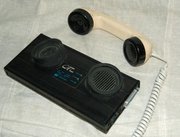Acoustic coupler
|
|

In telecommunications, the term acoustic coupler has the following meanings:
- An interface device for coupling electrical signals by acoustical means--usually into and out of a telephone instrument.
- A terminal device used to link data terminals and radio sets with the telephone network.
Note: The link is achieved through acoustic (sound) signals rather than through direct electrical connection.
Prior to the deregulation of telephony in many countries of the world, it was illegal to make an electrical connection to the telephone network. With the increased use of computing, acoustic couplers were used to connect modems to the telephone network.
Usually, a standard telephone handset was placed into a cradle that had been engineered to fit closely (by the use of rubber seals) around the microphone and earpiece of the handset. A modem would modulate a loudspeaker in the cup attached to the handsets microphone, and the loudspeaker in the telephone handset's earpiece would be picked up by a microphone in the cup attached to the earpiece. In this way a two-way signal could be passed.
Speeds were typically 300 bits per second achieved by modulating a carrier at 300 baud. The first such device was the ACOUSTIC DATA COUPLER 300 MODEM from 1968.
Acoustic couplers were sensitive to external noise and depended on the widespread standardisation of the dimensions of telephone handsets. Once electrical connection to telephone networks became legal, it rapidly became the preferred method of attaching modems.
Acoustic couplers are still used by people travelling in areas of the world where electrical connection to the telephone network is illegal or impractical.
